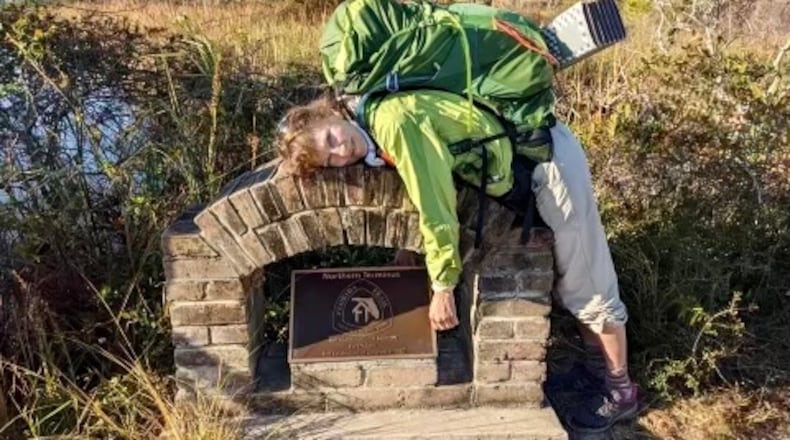Seven years ago, at 60, the Fairborn grandmother of four decided she wanted to “live life in a bigger way.”
“I wanted to do things that were challenging,” she said. “At my age, I relish ‘first’ experiences. The more I hiked and backpacked, the more confident I became that I could actually physically and mentally do this.”
Power recently completed a section hike of the 1,100-mile Florida Trail.
“My goal was to challenge myself to do something I had never done before – find adventure, meet new people, find a new purpose for getting out of bed every morning, do something I enjoy.”
The long-distance section hiker shares her experience in her own words.
Q: You came to hiking later than some, what challenges did that present?
A: I have never felt that age is a challenge on a wilderness trail or any trail for that matter. Trail mantra is “hike your own hike” which means you can set your own daily mileage; you can stop for breaks whenever you’re tired; you can get on the trail for a few hours, a few days or a few months. I’ve also learned to take out my foam pad, plop down, and nap for 20 or 30 minutes if I’m on a long hike.
Q: What made you decide to tackle the Florida Trail?
I didn’t quite know what I was getting into with the Florida Trail. I had Disney World images of the Sunshine State as a way to escape winter in Ohio. Initially, I went to Florida in 2018 to “tagalong” for the first 100 miles with Andy “Captain Blue” Niekamp. We started at the southern terminus in Big Cypress National Preserve in the Everglades. I thought I was going to die. We did two-and-a-half days of nearly constant swamp hiking – the kind where the tannin-laced swamp water is above your knees, and you can’t see your feet or where you’re stepping. Or, for that matter, you can’t see anything else that’s in the water with you – venomous snakes, alligators, spiders. But that first trip was the adventure of a lifetime. Snakes and alligators be damned. I was hooked.
Q: What was the most challenging aspect of that journey and what was most rewarding?
The most challenging aspect of the Florida Trail, as with any trail, is the fear of getting lost or losing the trail. I can deal with the heat, the cold, the rain, the sand, walking 15 to 20 miles a day with a 26-pound pack on my back, sore feet, sleeping on the ground, eating my meals out of a foil bag, putting on wet shoes and stinky socks and clothes every day. But I get a sinking feeling in my stomach when I can’t see my hiking partner, don’t know where I am or am not sure which way to go.
Hiking isn’t always fun, but it never fails to be a challenge and that’s the part I find rewarding. As a female and as a senior, it’s empowering. I’m doing something good for myself physically, emotionally and psychologically. I am carrying everything I need to live for weeks at a time on my back. I wake up every morning on the trail with a sense of wanderlust. Every day there is a new place to go, new sights to see, new people to meet. Each day is a new adventure.
Q: What has hiking added to your life?
A: I have health issues. I am enjoying the health benefits hiking brings. It has made my bones stronger, and I’m convinced it’s keeping my blood pressure normal and my lungs as healthy as they can be. Hiking also led me to other opportunities. I became an Ohio certified volunteer naturalist in 2019; I lead interpretive hikes at Oakes Quarry in Fairborn. I’ve also made a new circle of friends who love to hike, too. Hiking is good for the body, soul, and social life. I’m living life in a bigger way.
Never too late – Power’s advice for senior hiking rookies
1. Educate yourself on trails. Attending a hiking presentation by Dayton Hikers or Five Rivers MetroParks is a way to see if hiking appeals to you.
2. Be prepared when you hike. Younger people may be able to get away with hiking in flip flops without carrying water, but it just makes sense to do the minimum – buy quality hiking shoes, poles and a lightweight day pack.
3. Hike with a friend or in a group. I joined Dayton Hikers in 2013. Start with a slow-paced, shorter hike. Hike regularly. You’ll be amazed at how fast your stamina increases by just hiking once a week.
4. If you’re limited in mobility, start with hard, smooth surfaces. A city park trail offers just as much benefit as hiking in the woods.
5. Consider the possibilities. It’s sometimes hard for seniors to start something new that will take us out of our comfort zones. Give yourself the latitude to try hiking.
Walking on Sunshine - A Thru Hike of the 1,100-Mile Florida Trail
What: Andy “Captain Blue” Niekamp shares his adventures from the 1,100-mile journey from the Everglades to Pensacola. The Florida Trail ranges from remote and wild knee-deep swamps to bike paths through busy suburban Orlando to the white, sandy beaches of the Panhandle. Learn how Andy endured sun, heat, rain, wind, cold, floods, hurricane damage, alligators and venomous snakes to complete this 2.5-month hike.
When: Jan. 5, 6:30 p.m.
Where: Springboro Municipal Building, Community Room, 320 W. Central Ave.
Who: Free and open to the public
About the Author



